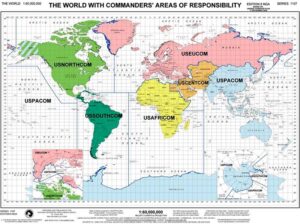Cut Pay? Trim COCOMs: How To Act Wisely On Military Pay
Posted on
Imagine a business that’s restructuring costs. The idea is to restrain employee compensation and free up money for operations and investment, thus allowing the company to grow. Everyone’s familiar with the surrounding debate: leaders spotlight the need for efficiency, and workers insist that the company not break faith with them. It’s a classic dispute between management and labor.
Now imagine that this organization isn’t a business, but rather the Pentagon. It shouldn’t require too much creativity. Congress chartered the Military Compensation and Retirement Modernization Commission to address this exact circumstance – rather than doing so itself – and the commission will report out in the coming weeks.
It’s helpful to look at this from a management-labor perspective. The Pentagon’s front office could lighten the load on our service-members by paring geographic combatant commands, the sprawling globe-spanning headquarters that set the military’s tasks and run its operations, in exchange for asking service-members to accept new limits on their future compensation.
Before getting to a deal like this, the stakeholders and the arbiter – Congress – have to accept limits. The purpose of a business is to grow, while the military’s mission is to defend our national interests at the lowest reasonable cost to the taxpayers and the nation. By extension, any savings that the military can generate should be returned to the public rather than reinvested, unless there is an overriding national security interest.
Acknowledging that limit, the parallels in management-labor relations are striking, and plans to wring savings from service-members’ compensation are well-established.
In the fifteen years up to now, service-members’ annual raises have outpaced inflation in 10 years, matched it in three, and fallen short only in the last two. Then they get allowances that cover 99 percent of their housing and help offset their groceries. Military health insurance is a tenth the cost of similar plans on the private market. And, for those who advance 20 years to retirement, they get a guaranteed, lifetime pension equaling half of their highest years’ salary.
This kind of system is rare in the American marketplace, and it’s costly.
That does not mean, however, that operations or investments are underfunded. The Pentagon’s front office suggests that this is the case, but Congress must not take that for granted as it considers how to act on the commission’s recommended efficiencies. Indeed, overstating national security necessity, and hence overburdening our service-members, is a constant temptation for the Defense Department, inherent in its structure and processes.
First, defense managers have a strong incentive to grow their institution, just like any bureaucracy, and that requires them to argue that the US faces overriding national security necessities. It should come as no surprise that they point to an ever-growing list of threats, but that doesn’t mean all of those threats deserve priority. Congress makes the final calls on our security imperatives, represented by the things it buys or doesn’t buy in the budget. Lawmakers have reason to scrutinize the Pentagon’s workload decisions as they consider the commission’s recommendations for limiting their compensation growth.
Second, the Pentagon contains institutions whose primary job is to generate work. Six geographic commands generate technical requirements for equipment and operations, and they’re entirely free from the obligation to set priorities or pay for the requirements they create. Congress could get the impression that our country is threatened merely because we’ve hired these combatant commanders to tell us that we’re threatened.
The Military Compensation and Retirement Modernization Commission will provoke a lot of debate on the alignment of work and pay, but it won’t require Congress to reach an objective consensus on them. Members just need to strike a relative balance. If lawmakers accept new limits on service-members’ compensation, then it also should impose stricter discipline over the mission requirements that the Pentagon sets for service-members.
The best way to do that is by downgrading combatant commands to focus on tasks rather than regions. These organizations already exist, including the counterterrorism-focused Joint Task Force – Horn of Africa. And, if downgrading proves too difficult, then Congress should at least require consolidation so that we have fewer combatant commands.
Congress has prolonged the Pentagon’s internal dispute between management and labor by chartering the Military Compensation and Retirement Modernization Commission, and the time has come to listen, debate and act. This friction has some parallels in the business world, especially regarding the need to compromise so that workers’ compensation aligns with their workload. But that analogy isn’t perfect. The Pentagon doesn’t exist to grow, like a business. It’s savings should go to the taxpayer, not internal reinvestment, except in cases of overriding military necessity, and Congress has plenty of reason to doubt such claims now.
Matthew Leatherman is an adviser to the Stimson Center and co-author of the 2013 report, “Managing the Military More Efficiently: Potential Savings Separate from Strategy.”
Subscribe to our newsletter
Promotions, new products and sales. Directly to your inbox.



